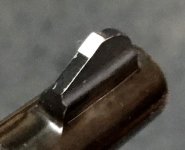One of the articles I read- maybe the one in link from my original post from our local tool store - also said to tap the bottle onto a solid surface to force the glue out of the nozzle and back into the bottle. Also good practice with wood glues, which always gum up the spout if not cleared.I was always bummed that after one use, the tube would harden or the cap would be stuck on the Super Glue tube.
Found out if you put the tube in a little zip lock bag and store it in the fridge, it lasts a long time. Been using the same tube over a year now.
Edit: Here's the blurb from my local tool store (KMS Tools):
Care & Keeping Of Cyanoacrylates
Although we provide a fresh product with a guaranteed two year shelf life, there are several things you can do to get the most from your KMS Cyanoacrylate Adhesives. Heat and moisture will decrease shelf life, so store your CAs away from accelerators and in a cool place that's not exposed to direct sunlight. Unopened and well-sealed bottles can be stored in the fridge or freezer to maintain freshness. Make sure you let it warm to room temperature before you use it though.
When you first open a bottle of KMS CA adhesive, loosen the cap and retighten to relieve any air pressure that might be inside. This will decrease the chance of any leaking out when you open the tip.
Hold the bottle upright against a near vertical surface and cut off the top 1/32″ with a knife or razor blade. Avoid squeezing the bottle.
To prevent clogging, don't let the tip of the nozzle touch a surface that INSTA-SET™, our CA Accelerator has been applied to. Before replacing the cap, or squeezing it to blow air up to clear the nozzle, rap the bottle down hard to move the CA remaining in the tip back down into the bottle. Now you can clear the tip and replace the cap.
Although we provide a fresh product with a guaranteed two year shelf life, there are several things you can do to get the most from your KMS Cyanoacrylate Adhesives. Heat and moisture will decrease shelf life, so store your CAs away from accelerators and in a cool place that's not exposed to direct sunlight. Unopened and well-sealed bottles can be stored in the fridge or freezer to maintain freshness. Make sure you let it warm to room temperature before you use it though.
When you first open a bottle of KMS CA adhesive, loosen the cap and retighten to relieve any air pressure that might be inside. This will decrease the chance of any leaking out when you open the tip.
Hold the bottle upright against a near vertical surface and cut off the top 1/32″ with a knife or razor blade. Avoid squeezing the bottle.
To prevent clogging, don't let the tip of the nozzle touch a surface that INSTA-SET™, our CA Accelerator has been applied to. Before replacing the cap, or squeezing it to blow air up to clear the nozzle, rap the bottle down hard to move the CA remaining in the tip back down into the bottle. Now you can clear the tip and replace the cap.
Last edited:


